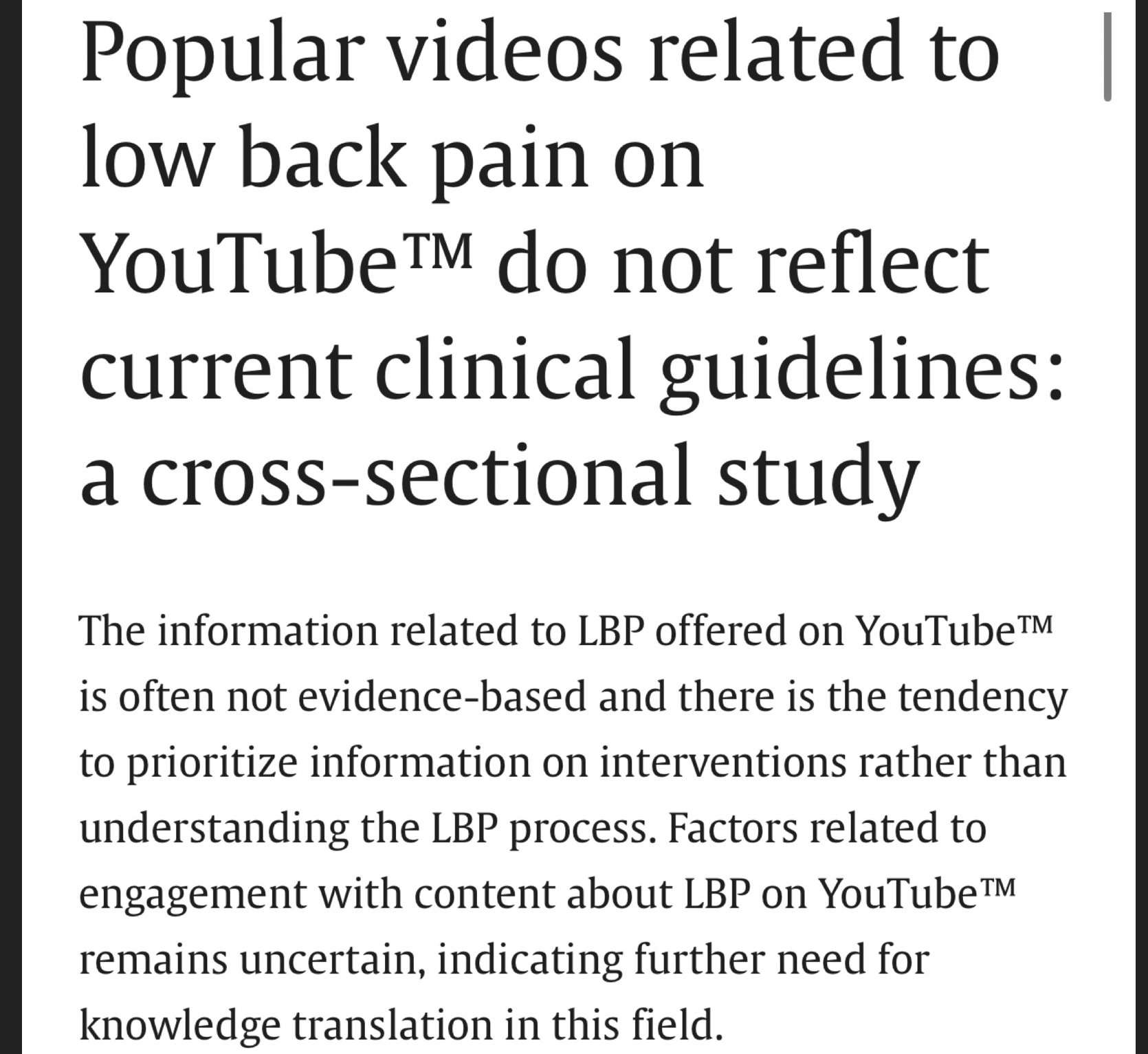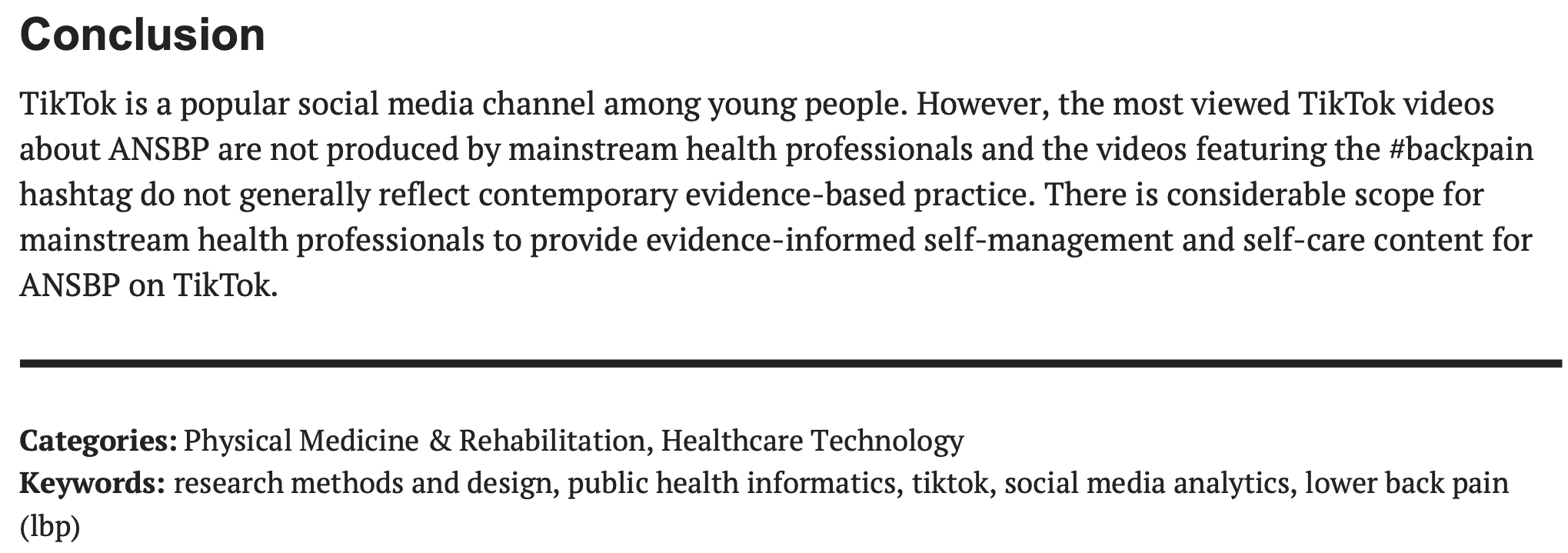How Fitness Is Getting Low Back Pain ALL Wrong!
2024-05-5
I actually have great sympathy for the modern fitness professional. For me, when I began in the late 90’s, most of the information we could learn about training came largely from textbooks (okay, we were all guilty of looking at some muscle magazines at the time), as the word was getting out that those fitness magazines weren’t quite the best resources for legitimate training information. NOW, coaches are incredibly FLOODED with everyone telling them what they should be doing in training and instead of credentials of studying these topics in academic and real life coaching situations, it is the number of followers and likes that one has that determines the “expert” on a topic. That is a very difficult and different world to navigate.
I’m not the old man trying to tell you that all social media is bad, but it is REALLY challenging to know what is legitimate and what is not. Just to prove my point, you can see that studies on social media show that a large amount of the information given is NOT based on any scientific evidence.


My hope is that posts like today’s can clear up a lot of the confusion around low back pain training and help clarify what we do know about helping low back pain. We don’t know everything, but we have some really solid solutions.
Core Stability
It use to be that anyone with low back pain was automatically going to get some core stability exercises. Then some new pain science came out showing that it wasn’t necessarily always core stability that we causing or helping low back pain. That of course got a bit twisted by mainstream training and the argument became that core stability doesn’t help low back pain. The research DOES show core stability can help low back pain!!!
“Core stability may provide great therapeutic effects in patients with non-specific chronic low back pain, reducing pain intensity, functional disability, and improving quality of life, core muscle activation, and thickness. Our review aimed to better elucidate the current evidences on the role of core-stability considering only high quality studies and grouping the studies on the basis of intervention modalities.” (1)
If you become popular and you are a researcher you will eventually be called “outdated”. That has happened around the internet as people have been attacking spine experts like Dr. Stuart McGill. I don’t think I can say that I agree with anyone 100% of the time (heck, including myself when I look back) but Dr. McGill has done some of the most extensive research on causes of low back pain as well as being pretty open minded to new ideas. To say he is “outdated” and wrong just isn’t served by the evidence.
A 2018 study went to see if Dr. McGill’s core stability ideas helped low back pain anymore than typical physical therapy. What did they find?
” Improvements in the clinical characteristics of CNSLBP in McGill stabilization exercises group were clinically and statistically greater (p<0.05). Although improvements in the most symptoms of CNSLBP in conventional physiotherapy exercises were not statistically significant, those are of great importance from the clinical point of view. Although these improvements did not differ between the two groups, it appears that McGill stabilization exercises provide an additional benefit to patients with CNSLBP, especially in pain and functional disability. This can be explained by some evidences that McGill stabilization exercises may increase stiffness and improve coordination between the antero-posterior and lateral lumbar muscles. This might in turn, create a stable lumbar spine during functional activities as well as help to reduce pain and improve function in patients with low back pain.” (2)
Exercises like the bird dog drags that we teach in DVRT are a great example of very progressive forms of core training that can definitely help low back pain.
Stretching
Whenever people feel pain or discomfort they have been taught that they need to stretch. Stretching is not necessarily a bad thing as long as we are more aware of what we are trying to stretch. There has also been a recent movement online to say tightness in areas of the body, like the hip flexors, are due to weakness not lack of flexibility. What I think people misunderstand when they say this are a few things…
First, there is quite a bit of evidence, even in recent studies, that stretching does improve pain and functional ability in those with low back pain (3). So, stretching can most definitely help low back pain, functional ability, and range of motion. What I think people ACTUALLY mean (they don’t really understand) is that there is also research showing that motor control/core stability exercises can help mobility and pain levels as well (4).
It really isn’t that the hip flexors need to get stronger, it is true that they will become over active though when the other systems of the body to provide stability to the body don’t work correctly. That is why both stretching and stability exercises like these are so helpful.
View this post on Instagram
That is a lot so, I wanted to make this a two part series about low back pain. I hope that you start to better understand what is a very complicated subject and what is real and what is kinda what I call “social media science”. The point of these posts are to help you better be able to help yourself or others with better information.
Find out more through our corrective exercise programs that are 30% with code “corrective ” HERE
View this post on Instagram
References:
- Frizziero, A.; Pellizzon, G.; Vittadini, F.; Bigliardi, D.; Costantino, C. Efficacy of Core Stability in Non-Specific Chronic Low Back Pain. J. Funct. Morphol. Kinesiol. 2021, 6, 37. https://doi.org/10.3390/jfmk6020037
- Ghorbanpour A, Azghani MR, Taghipour M, Salahzadeh Z, Ghaderi F, Oskouei AE. Effects of McGill stabilization exercises and conventional physiotherapy on pain, functional disability and active back range of motion in patients with chronic non-specific low back pain. J Phys Ther Sci. 2018 Apr;30(4):481-485. doi: 10.1589/jpts.30.481. Epub 2018 Apr 13. PMID: 29706690; PMCID: PMC5908986.
- Hatefi, Mohamadreza, Farideh Babakhani, and Mohadeseh Ashrafizadeh. “The effect of static stretching exercises on hip range of motion, pain, and disability in patients with non-specific low back pain.” Journal of experimental orthopaedics 8 (2021): 1-6.
- Moreside JM, McGill SM. Hip joint range of motion improvements using three different interventions. J Strength Cond Res. 2012 May;26(5):1265-73. doi: 10.1519/JSC.0b013e31824f2351. PMID: 22344062.
© 2026 Ultimate Sandbag Training. Site by Jennifer Web Design.







